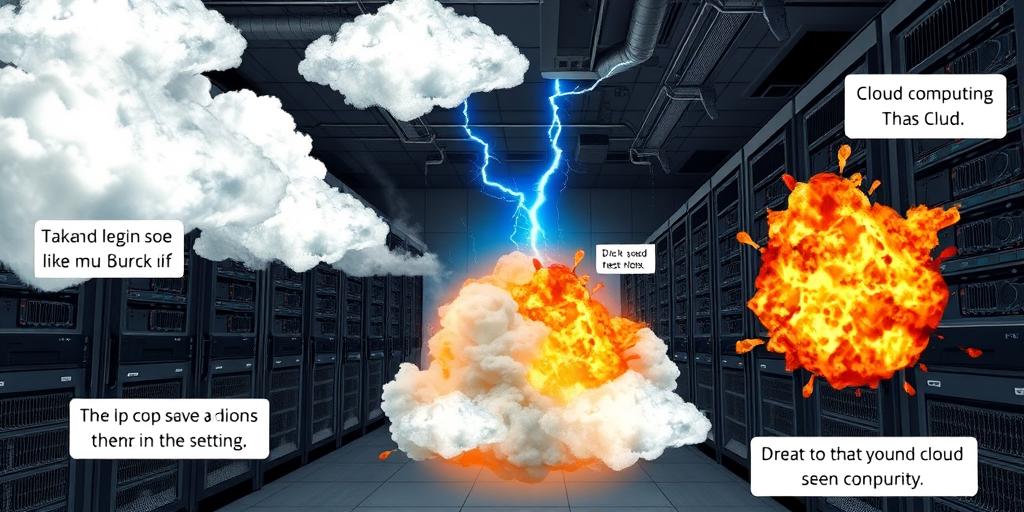The world of cloud computing is full of amazing possibilities, but it’s also a world where things can sometimes go hilariously wrong. From accidental data deletions to website outages that make headlines, the stories of “Cloud Computing Fails” are a reminder that technology isn’t always perfect, and sometimes the most unexpected things can happen.
Introduction: Laughing at the Cloud’s Quirks
While cloud computing offers incredible benefits, it’s not without its quirks. These quirks can sometimes lead to funny, and sometimes frustrating, situations. The good news is that learning from these failures helps everyone in the industry improve their cloud security and reliability.
Data Deletion Disasters: When the Cloud Forgets
One of the most common cloud computing fails involves data loss. It’s a scary thought, but sometimes the cloud can forget your data, or worse, delete it entirely.
The Case of the Missing Emails
Imagine you’re a business owner who relies heavily on email for communication. One day, you suddenly can’t access any emails from the past few months. You check your cloud provider’s support forums and find dozens of similar complaints. Turns out, a server glitch caused a massive email deletion, leaving businesses scrambling to recover their data. This real-life story highlights the importance of regular backups and redundancy.
Accidental Database Purges
Another data deletion disaster occurs when someone accidentally purges an entire database. This can happen due to a misconfigured script, a user error, or even a simple typo. Imagine a company’s entire customer database disappearing in a flash, leaving them unable to contact their customers or access important data. The aftermath of such a disaster can be costly and time-consuming, emphasizing the need for robust data recovery plans.
Downtime Debacles: When the Cloud Goes Offline
We all rely on the cloud for seamless access to our data and applications. However, what happens when the cloud goes down? Downtime can be a major headache for businesses and individuals alike.
The Great Website Outage of 2023
Remember that time when a major cloud provider experienced a massive outage, taking down thousands of websites and apps across the globe? The resulting chaos highlighted the vulnerability of businesses that rely solely on cloud services. This event serves as a stark reminder of the importance of having backup plans and disaster recovery strategies in place.
The Cloud Provider’s “Oops” Moment
Sometimes, cloud provider outages are caused by simple mistakes. Imagine a cloud engineer accidentally disabling a critical server during maintenance, causing a widespread outage. While these incidents are usually resolved quickly, they can cause significant disruption and frustration for users. This highlights the importance of careful planning, thorough testing, and meticulous attention to detail when managing cloud infrastructure.
Configuration Chaos: When Settings Go Wrong
Cloud platforms offer a wide range of configuration options, but sometimes these settings can be easily misconfigured, leading to unexpected consequences.
The Accidental Public Cloud Exposure
Imagine a company accidentally exposing sensitive data to the public internet due to a misconfigured security setting. This could have disastrous consequences, leading to data breaches, financial losses, and reputational damage. The incident underscores the importance of proper security training and regular security audits to ensure that cloud configurations are secure and compliant.
The Misconfigured Firewall
A misconfigured firewall can leave your cloud infrastructure vulnerable to attacks. Imagine a firewall rule that accidentally blocks access to a critical service, causing a major disruption to your business operations. This scenario emphasizes the need for careful attention to detail when configuring firewalls and other security measures in the cloud.
Security Shenanigans: When the Cloud Gets Hacked
Cloud computing offers many benefits, but it also presents unique security challenges.
The Cloud-Based Ransomware Attack
Imagine a ransomware attack targeting a company’s cloud-based infrastructure, encrypting critical data and demanding a ransom for its release. This scenario highlights the importance of strong security measures, including robust encryption, multi-factor authentication, and regular security updates.
The Data Breach That Wasn’t
Sometimes, security incidents can be a bit more comical. Imagine a company experiencing a “data breach” that turns out to be a false alarm, caused by a rogue script or a misunderstanding of security logs. While these incidents may not be as serious as a real data breach, they can still cause stress and disruption. The importance of having clear incident response procedures and accurate security monitoring systems is crucial.
Learning from Cloud Computing Fails
While cloud computing fails can be frustrating, they offer valuable lessons for everyone involved.
The Importance of Backup and Recovery
One of the most important takeaways from these stories is the importance of having robust backup and recovery plans in place. Regularly backing up your data and ensuring you can restore it quickly is essential for mitigating the impact of data loss.
The Value of Thorough Testing
Thorough testing is critical for avoiding configuration errors and ensuring that cloud applications and services are working as expected. Before deploying any changes to your cloud infrastructure, make sure to test them thoroughly in a staging environment.
The Need for Strong Security Practices
Finally, it’s essential to maintain strong security practices in the cloud. This includes implementing robust encryption, multi-factor authentication, and regularly updating software and security configurations. By taking these steps, you can reduce the risk of security incidents and protect your data from malicious actors.
Cloud computing is a powerful tool, but it’s important to remember that technology isn’t always perfect. By learning from cloud computing fails, we can improve our cloud security practices, avoid costly mistakes, and ultimately get the most out of the cloud.




